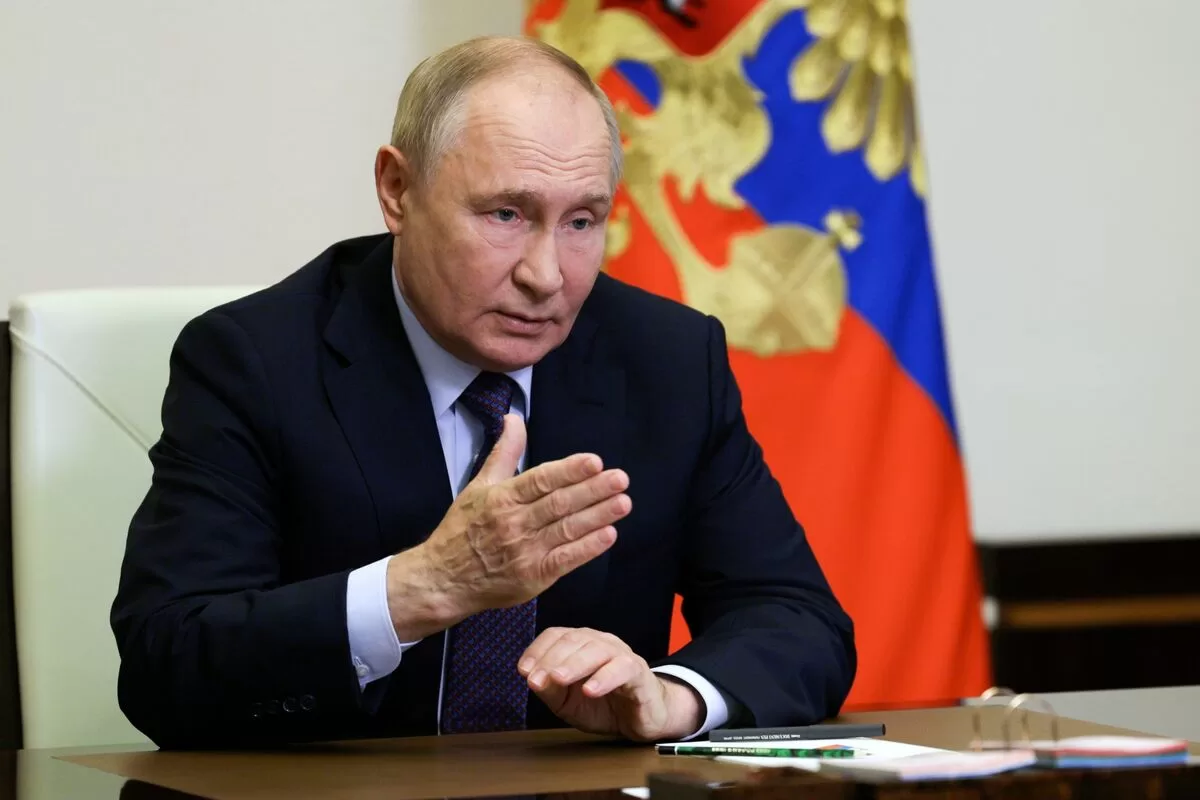Vladimir Putin:Photographer: Aleksey Babushkin/Sputnik/AP
On August 25, 2024, Russian President Vladimir Putin held meetings with top military commanders to discuss the ongoing situation in Ukraine. This comes as Ukrainian President Volodymyr Zelenskiy addressed visiting Indian media, reiterating his nation’s goal for a “fair peace.” The timing of these developments adds new layers to the ongoing conflict, as both leaders maneuver through a war that has gripped the region for over a year and a half.
Putin’s meeting with military officials occurred in the Kursk region, an area that has seen escalating tensions due to Ukrainian military operations. This region, bordering Ukraine, has been one of the focal points in the ongoing war, with both sides experiencing losses and victories in recent months. The Russian president received detailed briefings from his commanders about the current military situation. Sources close to the Kremlin revealed that these discussions primarily focused on defensive strategies and the possibility of counterattacks aimed at slowing Ukraine’s advance.
At the same time, Zelenskiy spoke with Indian media representatives who were visiting Ukraine as part of a diplomatic mission. Zelenskiy reiterated Ukraine’s commitment to a peaceful resolution of the conflict but stressed that any peace must be “fair” and “just” for Ukraine. He suggested that Ukraine’s recent operations in Russian-held territories, including the Kursk region, are part of a broader strategy. This strategy combines military action with political and diplomatic efforts aimed at forcing Russia to the negotiating table.
The war, which started in February 2022 with Russia’s invasion of Ukraine, has reached a critical phase. Both Russia and Ukraine are now focused on gaining the upper hand before any potential peace talks take place. While the Ukrainian president emphasized diplomacy, his military continues its efforts to reclaim lost territories, including areas Russia annexed in 2022. Russia, on the other hand, remains focused on solidifying its control over those territories, leading to a bloody stalemate.
Putin’s decision to meet directly with military commanders signals the gravity of the situation for Russia. Reports suggest that Russian forces are stretched thin across multiple fronts, including in eastern and southern Ukraine. There are growing concerns within the Russian military about Ukraine’s recent gains, particularly in the Zaporizhzhia and Kharkiv regions. Despite these setbacks, Putin’s government has maintained a strong public stance, claiming that Russia is still in control of key strategic areas.
Meanwhile, Zelenskiy’s comments about a “fair peace” hint at Ukraine’s larger objectives. Ukrainian officials have consistently argued that any ceasefire or peace agreement must include the return of all Ukrainian territories currently occupied by Russia. This includes not only areas seized during the current conflict but also Crimea, which Russia annexed in 2014. However, achieving such a peace would require significant international support, something Zelenskiy is working to secure through his diplomatic engagements.
Zelenskiy’s meeting with the Indian media is part of Ukraine’s broader diplomatic efforts to gain support from non-Western countries. India, which has maintained a neutral stance in the conflict, is seen as a key player in any future peace negotiations. Zelenskiy’s government is hopeful that by engaging with countries like India, they can build a global coalition that pressures Russia into accepting Ukraine’s terms for peace.
Despite these diplomatic overtures, the reality on the ground remains bleak. Fighting continues across several fronts, with neither side willing to back down. Ukraine has made some advances in recent months, but these have come at a high cost. Russia, for its part, has managed to maintain control over several key regions, including Crimea and parts of Donetsk and Luhansk.
The war has also taken a toll on both countries’ economies and populations. Ukraine has been heavily reliant on Western aid to sustain its military and rebuild its infrastructure. Russia, meanwhile, has faced international sanctions that have crippled parts of its economy, though it continues to find ways to circumvent some of these measures.
As the conflict drags on, both leaders are under pressure to show results. Zelenskiy’s government needs to demonstrate to its people that the sacrifices made by the Ukrainian military and civilians are leading to concrete gains. Putin, on the other hand, faces growing criticism from hardliners within Russia who believe the war has not gone according to plan. His decision to meet with commanders in person could be seen as an attempt to reassure both the military and the public that Russia remains committed to achieving its objectives.
While the future of the conflict remains uncertain, one thing is clear: both Putin and Zelenskiy are far from ready to back down. With winter approaching, the war is expected to enter a new phase, as both sides prepare for what could be a prolonged struggle. Whether through military action or diplomacy, the road to peace will be long and difficult.
As of now, Putin’s meeting with his commanders and Zelenskiy’s diplomatic efforts represent the two sides of the same coin in this conflict. Both leaders are playing a high-stakes game, with the fate of their nations hanging in the balance. The coming weeks will be crucial in determining whether this war continues to escalate or if there is a path toward peace.
#PutinZelenskiyMeetings #UkraineConflictUpdate #PeaceInUkraine #RussiaUkraineWar #MilitaryBriefing
